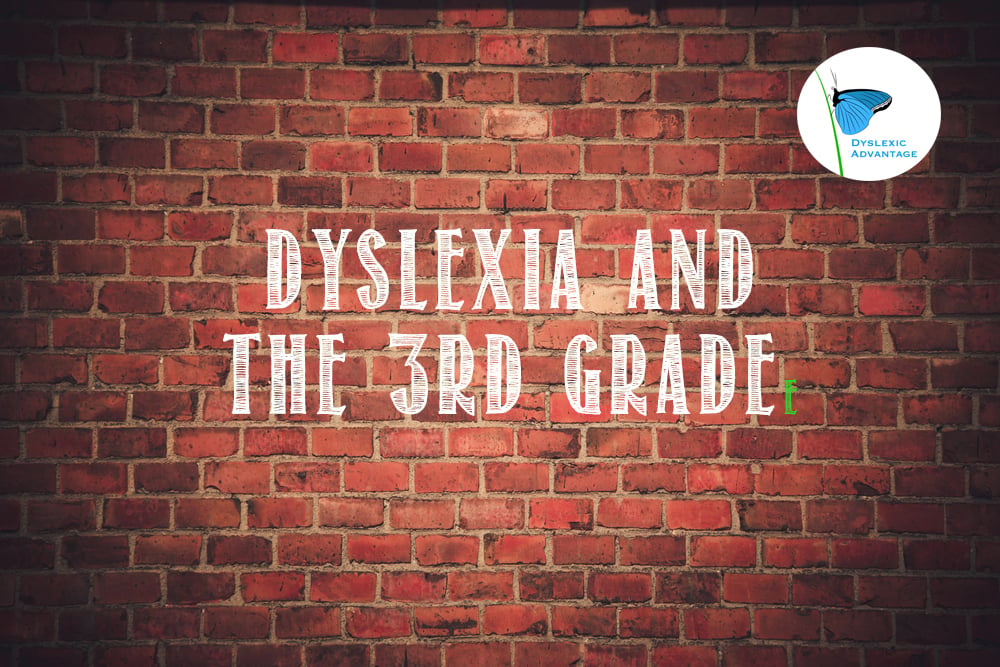In our last post, we wrote about the 3rd grade gap or wall. Dyslexic students typically get through the hard slog of phonemic awareness and then parents and teachers breathe a sigh of relief. Many times, the extra work fades away and students are integrated back into their usual classroom routine. All seems well, but a problem may remain. Reading remains effortful and the complexity of the text goes up. Students may not be able to keep up. With little extra help and too little time to complete assignments, the “guess and go” approach may dominate the reading strategy so that the gap between peers increases. A large part of the problem may be that students have not effective strategy to read long words. These problems can come […]
Dyslexia and the Third Grade Wall
If you're not aware if the '3rd Grade Wall', you can get blind-sided. A recurring theme that we hear about when we interview accomplished dyslexic men and women is the trouble and failure (often grade retention) that happens in the 3rd grade. Why? What's the big deal...
PACIFIC STUDIO VISIT: Interview with Michael Graham about his ‘Dream Job’ Making Museum Exhibits
This past summer, our high school volunteer Krista, my son, and I had a wonderful opportunity to visit Michael Graham, High End Fabrication Program Manager for Pacific Studio in Seattle. Michael has what many would call a dream job - making exhibits for museums all...
Dyslexia and Medical School – AMA Journal of Ethics [Premium]
In an important article published in the AMA Journal of Ethics, physicians call for mandatory dyslexia training for medical school faculty. The article presents the case of a 1st year dyslexic medical student who excelled in college and in clinical research, but who is conflicted about whether to disclose his dyslexia to faculty and fellow classmates because of his concerns that it would negatively impact his “education, performance, and reputation.” The writers comment: “Given the scientific progress in understanding the epidemiology, cognitive basis, and neurobiology of dyslexia, it is surprising that ignorance of the condition persists; such ignorance continues to result in faculty misperceptions of dyslexia. For example, the very common and physiologically based symptom of slow reading in dyslexia can be misinterpreted as slow […]
Math and Dyslexia: Dyslexic Advantage Talks to Stanford & Georgetown Experts Tanya Evans and Michael Ullman
Last week, I had a chance to chat with Stanford's Tanya Evans and Georgetown's Michael Ullman about their recent research paper about procedural learning and math. In their paper, their definition of procedural learning relates to the type of learning that...
DEAN KAMEN INVENTOR [Premium]
“If you start to do things you’ve never done before, you’re probably going to fail at least some of the time…and I say that’s ok.” – Dean Kamen Dean Kamen is one of the world’s most prolific inventors with over 440 patents to his name – including the Segway, the Luke Arm (robotic prosthesis), a programmable insulin pump and portable water purifier for Third World Countries. He also created the FIRST LEGO league to encourage young people to build and engineer, and he considers that his most important accomplishment. Dean’s father was an illustrator for MAD magazine and Weird Science and his mother was a teacher. Precocious at a young age, he remembers inventing a way to make his bed without having to cross to […]
How To Become Invincible – Sort Of
Well, maybe not invincible, but you know what we mean. There's a new idea circulating among business leaders and entrepreneurs. It's not mindset or grit, but of course those are important. It's rejection therapy. Some people think part of the reason for higher than...
October is National Dyslexia Awareness Month – What Will You Do?
It's hard to believe the Dyslexia Awareness Month was only officially recognized by US Congress lin 2015. Although 120 years have passed since Pringle Morgan noticed the intelligence and reading discrepancy in a student, we are still only in our infancy in terms of...
How to Read to Kids with Dyslexia – Reading As a Conversation [Premium]
There are many good ways to read to children with dyslexia. In this post, we wanted to talk share an approach that some have called “dialogic” or like a dialogue. A dialogue is a back and forth conversation, and that is exactly how this style of reading goes. Rather than having a parent or teacher read aloud with a child listening, in dialogic reading, the adult helps the child tell the story. The acronym for this method is PEER: 1. Prompt a child to say something about the book. 2. Evaluate her response. 3. Expand the response by rephrasing and adding more detail, and 4. Repeat the prompt to make sure the child learned. Except for the first reading of the book, PEER sequences should […]
Math Strategies for Arithmetic – Number Flexibility [Premium]
“Everybody could rock through their multiplication tables and I could do my ones and my twos and my zeros and my tens, and that was about it.” – Jack Laws, naturalist I’ve been enjoying a book, Mathematical Mindsets written by Stanford Professor Jo Boaler. It’s great stuff. She’ll help a lot of dyslexic students if they adopt her approaches to teaching math. The first concept is deceptively simple, but resonates with me after seeing over a decade of dyslexic students work math problems in our clinic. There is a high degree of overlap between dyscalculia and dyslexia although there is also a significant number of dyslexics who are solid or even outstanding mathematicians. The weak ones almost invariably struggle with basic math facts and require […]
Choosing the Right Reading Level Books for Students with Dyslexia [Premium]
It’s often told to parents that a “Five Finger Rule” can help you choose whether a book is at the right reading level for a student. The rule states that if a student misses five or more words, it may be too hard, no words and it might be too easy, and three words and it’s ‘just right’. The problem for dyslexic students is that the “Five Finger Rule” may prevent them accessing print information at their intellectual level and if reading aloud is the guide for the rule, then it’s possible they may never be granted access to higher level books even if they are university professors! In fact, pioneering work by Rosalie Fink (see research paper below for Premium members), showed that accomplished […]
Q: How Can My Student Be Tested for Dyscalculia ? [Premium}
The last decade has seen a great advance in the biological understanding of dyscalculia, or math disability. The DSM V groups a specific learning disorder in math (315.1) under Specific Learning Disability along with impairment in reading (315.000) and impairment in written expression (315.2). The NIH defines dyscalculia as a condition contributes to “difficulty understanding arithmetic concepts and doing such tasks as addition, multiplication, and measuring.” It is important to identify dyscalculia, because an unrecognized LD can contribute to cycles of academic underachievement, secondary behavioral and emotional issues, and obstacles to further academic or workplace advancement. With the recent addition of high-stakes exams like the calculator-free section of the new SAT, it is even more critical that students with dyscalculia be identified. The DSM V definition includes the […]

![Bridging the Gap to Reading Long Words [Premium]](https://www.dyslexicadvantage.org/wp-content/uploads/2016/11/Screen-Shot-2016-11-04-at-9.52.37-AM.jpg)


![Dyslexia and Medical School – AMA Journal of Ethics [Premium]](https://www.dyslexicadvantage.org/wp-content/uploads/2016/11/Screen-Shot-2019-09-03-at-3.44.07-PM.jpg)

![DEAN KAMEN INVENTOR [Premium]](https://www.dyslexicadvantage.org/wp-content/uploads/2016/10/Screen-Shot-2019-09-10-at-12.32.34-PM.jpg)


![How to Read to Kids with Dyslexia – Reading As a Conversation [Premium]](https://www.dyslexicadvantage.org/wp-content/uploads/2016/10/mom-reading.jpg)
![Math Strategies for Arithmetic – Number Flexibility [Premium]](https://www.dyslexicadvantage.org/wp-content/uploads/2016/10/mental-math.jpg)
![Choosing the Right Reading Level Books for Students with Dyslexia [Premium]](https://www.dyslexicadvantage.org/wp-content/uploads/2016/10/reading-bulb-our-shutterstock-scaled.jpg)














